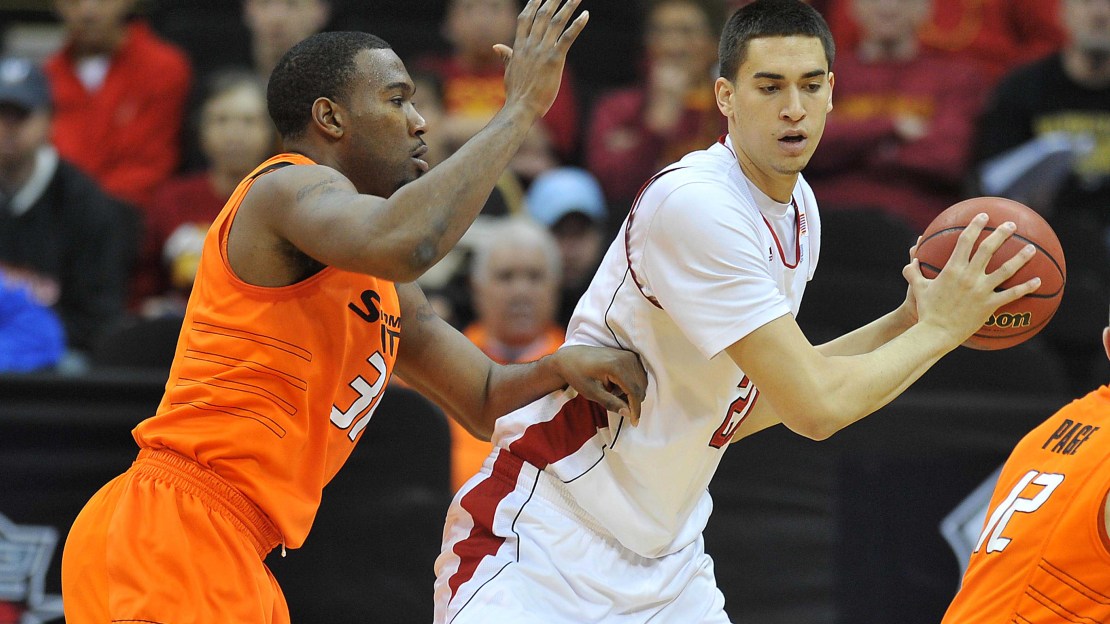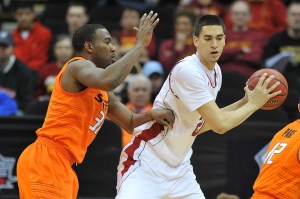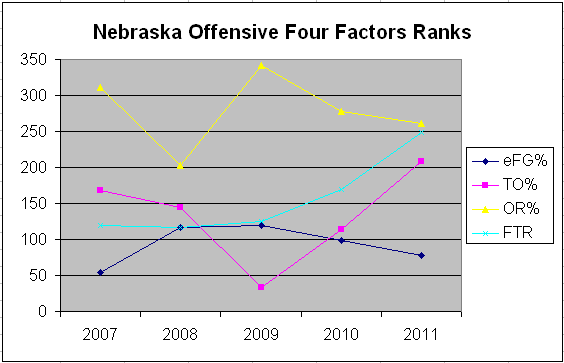BTN.com staff, November 10, 2011
Our season previews continue in reverse order of projected finish. Penn State, Iowa, and Northwestern have been covered. We now move on to the newest member of the Big Ten, the Nebraska Cornhuskers.
Nebraska
10-11 Overall Record: 19-13
10-11 Conference Record: 7-9 (Big 12)
10-11 Conference Efficiency Margin: -0.02 (Big 12)
Percent of Returning Minutes: 68.9
Percent of Returning Freshman Minutes: 0.0
Nebraska basketball is an unfamiliar animal to most Big Ten fans, much like the mountain lion or scores in the 90s. We know they exist, but we haven't really seen them. For ease of understanding, let's use this statement as a starting point:
This Nebraska squad is basically a mirror image of Northwestern.
Don't believe me? Check out last season's adjusted efficiency ranks:
| Off. Eff. Rank | Def. Eff. Rank | |
|---|---|---|
| Northwestern | 18 | 121 |
| Nebraska | 116 | 24 |
Just as the Wildcats were held back by their defense, the Cornhuskers were dragged down by an inability to score. Nebraska has been to the NCAA Tournament before, but it's been 13 years. And like Northwestern, Nebraska returns most of their roster but must replace a heady senior point guard (in this case, Lance Jeter). There's a lot of parallels, and we're projecting the two teams to finish side by side in the Big Ten.
Nebraska's defense is keyed by interior dominance, led by 6-11 centers Jorge Brian Diaz and Andre Almeida. Both are both excellent shot blockers, helping the Huskers hold opponents to 42 percent shooting on twos last season. When those opponents missed, Nebraska was among the nation's very best at securing the carom. Jeter hit the glass well for a point guard, but his absence shouldn't change those strengths. Much like Northwestern's offense, Nebraska's defense is plenty good enough for an at-large bid.
But oh that offense. Doc Sadler's team is instantly in the running for Big Ten's worst offense, as they must replace, in Jeter, their only reliably efficient player. Sadler has been the head coach at Nebraska for five seasons, and he has yet to put a good offense on the floor. Here's a chart showing where Nebraska's offense has ranked nationally in the four factors under Sadler's watch:
Remember that, since these are ranks, being closer to the bottom of the chart is better. The first thing we see is that Nebraska has consistently been a lackluster offensive rebounding team. We also see that free throws have become less and less of a weapon for the Huskers, and turnovers have gone from a strength to a weakness over the past three seasons. The one constant has been solid shooting, which last season was driven by converting nearly 53 percent of their twos. That was Nebraska's only real positive on the offensive end, so there's plenty of areas for improvement. Even small gains in each category could go a long way given how the Huskers defend.
Thankfully, Sadler does have some candidates to step in and help. Dylan Talley is a junior college transfer that should make an instant impact on the offensive end. The 6-5 wing was the America East Rookie of the Year while at Binghamton in 2009-10, then he transferred to Blinn College and averaged 22 points per game while shooting 54 percent on twos and 37 percent on threes. Talley also showed a nice ability to get to the foul line, so he could become one of Nebraska's top scoring threats in short order.
The bigger name–although not necessarily the better player–is LSU transfer Bo Spencer. The 6-2 combo guard was a legit three-point threat as an SEC sophomore, but his shooting really fell off as a junior:
| Shot% | 2pt FG% | 3pt FG% | FT Rate | |
|---|---|---|---|---|
| Spencer, 2007-08 | 15.1 | 21.1 | 17.6 | 5.5 |
| Spencer, 2008-09 | 20.8 | 40.3 | 40.3 | 20.1 |
| Spencer, 2009-10 | 26.9 | 38.1 | 29.3 | 26.2 |
Paired with his propensity to turn the ball over, Spencer was terribly inefficient two seasons ago yet enjoyed a very heavy shot diet. He does have a nice stroke from the foul line (career 83 percent) but doesn't get there enough to really make it matter. If the senior can shoot more like he did as a sophomore, Spencer can help the Huskers, but that's far from a sure thing.
This will be the Big Ten's most experienced team, with a rotation that will include five seniors and three juniors. They face a relatively easy nonconference schedule that could leave them undefeated–albeit with no top 50 wins–as they start Big Ten play. With that in mind, it will likely take a better than a .500 record in the Big Ten to snag an at-large bid, and we think the Huskers will fall just short of that. Nebraska will be competitive in their first Big Ten go-round, but don't expect that NCAA Tournament drought to end just yet.









